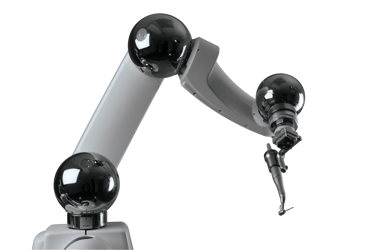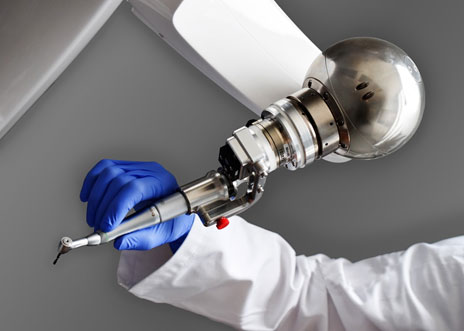Robotic Technology Is Disrupting Traditional Dental Implant Surgery — Here's How
By Alon Mozes, Ph.D., founder, Neocis

Proper dental health is essential to everyday life, and the physical and mental distress resulting from missing teeth can significantly impact our overall well-being. Dental implant surgery has become the standard of care for individuals with edentulism, which can be caused by inadequate dental care or trauma due to injury. The geriatric population is at increased risk, with nearly one in five American adults aged 65 or older having lost all their teeth.1
There are about 5.5 million dental implants placed annually.2 Although these surgeries are rising in frequency, dental implant procedures require extreme accuracy to avoid critical anatomical structures.
While robotic-assisted surgery has become increasingly commonplace across various medical specialties, most dental implant surgeries today are done utilizing a freehand approach with minimal guidance. In a field where precision and accuracy within a confined space are essential, robot-assisted technology can enable dental surgeons to operate with unsurpassed accuracy, ensuring the best functional as well as aesthetic results for patients.
The dental industry has expanded its embrace of robotic technology in recent years, paving the way for modernization in dentistry and priming robot-assisted surgery to become the method of choice over freehand dental implant procedures, for the benefit of both the provider and the patient.

The Limitations Of Traditional Dental Implant Surgery
Dental implant surgery typically involves replacing missing or damaged teeth with artificial ones, as well as replacing tooth roots with metal, screwlike posts.
During a traditional implant procedure, the surgeon drills a hole into the patient’s jawbone where the post is then placed. The implant fuses with the surrounding bone, providing a solid foundation for the abutment and artificial replacement crown that are then attached to mimic the appearance and functionality of a real tooth. While bridges and dentures can also be utilized in these cases, these alternatives can strain other healthy teeth and lead to bacterial infections. Furthermore, since such treatments are not fixed in the jawbone, they do not prevent bone resorption, which causes further physical and aesthetic decay. Additionally, traditional freehand techniques require surgeons to cut open the patient’s gum in order to access the surgical site, which can lead to post-surgical pain and longer recovery times.
To supplement freehand procedures, various guidance mechanisms have been introduced to the field. However, each has its own issues and restrictions. Even though they are more accurate than freehand, plastic surgical guides lack intraoperative flexibility, can obscure the view of the surgical field, and may be difficult to irrigate. Camera-based navigation provides intraoperative flexibility but requires the dental professional to operate while looking at a computer screen instead of at the actual surgical site. Furthermore, this system does not prevent the dental professional from deviating from the surgical plan.
Successfully placing dental implants requires careful preoperative planning and intraoperative flexibility, as well as a high degree of accuracy and precision to avoid critical anatomical structures and provide optimal outcomes for patients. Robotic-assisted technology offers the utmost accuracy and precision in dental treatment along with better workflows, effectively addressing the limitations of traditional implant techniques.
Implementing Cutting-Edge Surgical Technology – Without Cutting Tissue
By integrating digital pre-planning software, robot-assisted dental technology can help surgeons safely stick to the surgical plan.
Importantly, robotic-assisted dental technologies enable minimally invasive procedures, helping dentists to perform flapless techniques, thus avoiding unnecessary incisions and streamlining the recovery process for patients. Robotic systems currently in use offer precise and accurate physical guidance during surgery through haptic robotic technology, preventing drill deviation or over-drilling past pre-planned depth, thereby ensuring the surgeon avoids critical anatomy such as nerves or sinus cavities.
Haptic robotic technology provides physical feedback in real time to guide the surgeon’s movements, while constraining angle and depth according to the surgeon’s procedural plan.
To be clear, the surgeon is in control of the implant procedure at all times. Robot-assisted dental technologies enhance the surgeon’s existing expertise, rather than replacing it completely. The surgeon is the one planning and executing the operation. They are guided by robotic technology throughout the procedure to ensure maximum accuracy.
Navigating Complex Cases
In addition to increasing safety during surgery, robotic-assisted dental technology helps clinicians achieve successful outcomes in complex cases that might be difficult or impossible to navigate by hand. There are a wide variety of complex cases in dental surgery, ranging from implants in the aesthetic zone, implants near the sinus, multi-implant cases, and full arch surgery.
The accuracy of robotics enables surgeons to optimize the use of available bone, in some cases guiding them to place the implant precisely at the sinus floor, thereby avoiding the need for a sinus lift. Full arch cases also see great benefit from robotic guidance. Multiple implant cases become a straightforward assembly line process, which can streamline the clinical workflow and potentially reduce the overall surgical time. The robotic precision and resulting parallelism may also lead to faster prosthetic restoration.
Additionally, while analog plastic surgical guides create limitations when a clinician needs the ability to change direction during surgery, robot-assisted technology allows dental surgeons to easily navigate sudden changes during implant surgery. Surgeons often encounter unanticipated clinical conditions, such as softer bone or unexpected extraction results that require a change to their pre-operative plan. However, plastic guides are fixed, requiring the surgeon to decide whether to stick to a faulty plan or throw the guides away and conduct a flapped freehand surgery.
Robotics, on the other hand, makes it possible to adapt on-the-fly to clinical conditions. Robot-assisted dental technology enables surgeons to change the pre-operative plan mid-surgery and use robotic assistance updated in real time to continue guiding the procedure, without defaulting to a freehand approach. With the assistance of robotics, clinicians can achieve more successful procedures and lower the risk of failed implants.3
A New Standard Of Patient Care
By providing real-time visual and physical guidance during surgery, robot-assisted dental technology maximizes accuracy and precision while ensuring exact operational angulation, location, and depth in accordance with the surgical plan.
Today, as knowledge and understanding of robotics expands across the dental industry, the systems are increasingly being utilized to train the next generation of implant dentists. In fact, multiple leading U.S. dental schools have installed and integrated robotics into their standard curriculums.
Robot-assisted dental surgery is not a futuristic concept. It is here now and will only continue to grow in importance and presence. Robotics are essential in their ability to provide patients with the absolute best functional and aesthetic outcomes possible. Patient safety and experience are the primary focuses of dentistry, especially when it comes to implant surgery, so robotic implementations and procedural enhancements will naturally become standard in our industry over time.
The positive impact of robot-assisted technology on dental implant surgery underscores the importance of modernization for the industry as a whole. As the use of robotic-assisted dental technology grows among clinicians, there is an opportunity for the technology to be implemented into the dental industry more broadly, increasing the likelihood that manual procedures, and the issues that go along with them, will soon be considered a thing of the past.
About the Author:
 Alon Mozes has worked in computer graphics and image-guided applications for more than 20 years. He has led Neocis as CEO and cofounder since its inception, through early prototyping, the first FDA clearance in 2016 for a dental robotic surgery system, substantial venture capital fundraising, and successful commercial launch. Mozes started his career at Sportvision, creating real-time special effects, including the first-and-10 yellow line in NFL games, before moving to Mako Surgical, where he was a principal engineer developing the company’s groundbreaking Rio system for orthopedic robotic surgery. Mozes received his Ph.D. in biomedical engineering from the University of Miami and his B.S and M.Eng. degrees in computer science and engineering from the Massachusetts Institute of Technology (MIT).
Alon Mozes has worked in computer graphics and image-guided applications for more than 20 years. He has led Neocis as CEO and cofounder since its inception, through early prototyping, the first FDA clearance in 2016 for a dental robotic surgery system, substantial venture capital fundraising, and successful commercial launch. Mozes started his career at Sportvision, creating real-time special effects, including the first-and-10 yellow line in NFL games, before moving to Mako Surgical, where he was a principal engineer developing the company’s groundbreaking Rio system for orthopedic robotic surgery. Mozes received his Ph.D. in biomedical engineering from the University of Miami and his B.S and M.Eng. degrees in computer science and engineering from the Massachusetts Institute of Technology (MIT).
- https://www.cdc.gov/oralhealth/basics/adult-oral-health/adult_older.htm. Accessed December 10, 2020.
- https://www.aaid-implant.org/what-are-dental-implants/. Accessed December 10, 2020.
- Coutre L. Drilling into the future of robot-assisted dentistry. Modern Healthcare. Published September 25, 2019. Accessed October 29, 2020. https://www.modernhealthcare.com/technology/drilling-future-robot-assisted-dentistry
